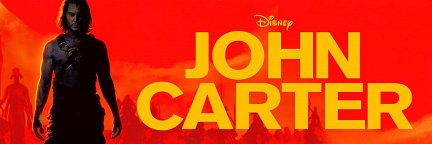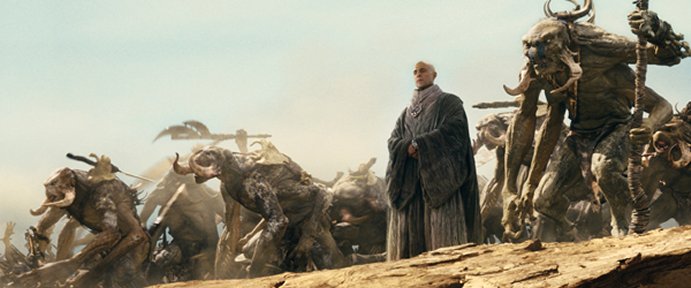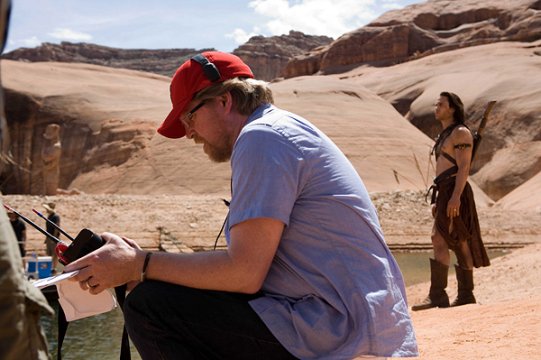
First and Only Weekly Online Fanzine Devoted to the Life and Works of Edgar Rice Burroughs Since 1996 Over 10,000 Webpages and Webzines in Archive Presents 
©Disney Enterprises, Inc. www.cartermovie.com Current News | 2011 | 2010 | 2009 | 2008 |

First and Only Weekly Online Fanzine Devoted to the Life and Works of Edgar Rice Burroughs Since 1996 Over 10,000 Webpages and Webzines in Archive Presents 
©Disney Enterprises, Inc. www.cartermovie.com Current News | 2011 | 2010 | 2009 | 2008 |

Describe your character in the film.
Mark Strong: I play a character called Matai Shang, who is the leader of a race called the Therns. Essentially, the Therns are a parasitic race that travels the universe creating the order that they need from it. So, in this particular story, they arrive on Mars, where they see two tribes at war and they decide to equip one tribe with the technology to vanquish the other tribe. It just so happens that John Carter comes along and falls in love with a woman from the soon-to-be vanquished tribe, so he exists over and above the action in the sense that heís not a Zodangan and heís not a Heliumiteóheís from Earth. The Therns are mythical on Mars; nobodyís quite sure whether they truly exist because nobodyís ever seen one. And as Therns, weíre able to transform ourselves into whoever or whatever we want in order to remain hidden and achieve our goals.Your character is very allied with the character of Sab Than, played by Dominic West. What is their relationship and why is your character so closely tied to him?
MS: Matai is closely allied to Sab Than as he is the leader of the Zodangans, whom the Therns have given special powers. The Therns made a decision very early on to give Sab Than and his tribe the technology to vanquish Helium, the tribe theyíre fighting. So, Matai and Sab are linked because Sab is taking his instruction from Matai.How does it feel to play a bad guy in ďJohn CarterĒ?
MS: It is a great challenge, in fact, to play the bad guy in any film. But I donít think of Matai as a bad guy. I donít see him as somebody whoís doing anything other than the best that he can. The way that you bring the bad guys to life and not make them two-dimensional is by giving them a purpose. Mataiís purpose is to create order in the universe. What he sees himself as doing is just and right and true. And he sees John Carter as somebody whoís getting in the way of that.So, in his mind, he doesnít think of himself as bad, or evil, or sinister. In fact, he has a wonderful speech to John Carter where he says, ďWe donít cause the destruction of worlds; we simply manage them.Ē And thatís what he sees himself doing.
Does your character Matai interact with any of the creatures in the film?
MS: Yes, in fact, Iím bitten by one of them because thereís this scene in which Woola attacks Matai. Itís going to be amazing to see how that comes out because basically in the filming of it, itís a guy in a green suit with a rubber dogís head biting my arm. So, a lot of it had to be created from oneís imagination. But obviously Iíve seen the art, so I understand what it is that I was acting against. I canít wait to see the manifestation of all of these ideas.Thereís a mystical element to the way the Therns operate and itís key to how the story gets set in motion. Can you explain how John Carter winds up on Mars and gets involved with that mystical part of the story?
MS: At the beginning of the story, John Carter finds himself in a cave on Earth and discovers what Iíve always thought of as a piece of Native American jewelry, or something like that, that actually turns out to be a very efficient piece of interstellar equipment and is the reason that he ultimately finds himself on Mars. Itís a piece of equipment that allows the Therns to transport themselves throughout the universe. So, I suppose we Therns are ultimately responsible for John Carter finding his way up to Mars.Can you describe the filmís idea of the future?
MS: Whatís wonderful about the film and the view of the future that Edgar Rice Burroughs had is that itís a Victorianís view of space, science fiction and other planets. Itís not the one that we have these days that you get from adapting a comic book. Today, we create a space full of laser guns and stuff like that, whereas in this film the guys still have swords, albeit amazingly outlandish looking ones. Itís almost art deco-looking. I think thatís why Iím fascinated by this particular film.What elements of the ďJohn CarterĒ story do you think will appeal to audiences?
MS: The story encompasses the things that make all great stories epic. There are communities at war; there is a love story; there is a sinister influence trying to prevent our hero from carrying out what he needs to. Itís about identity; itís about your place in the world, your place in the universe. On the simple story level thereís a man basically trying to discover who he is. And once heís found something he wants, fighting to keep it. I think all of those story elements are relatable and will appeal to audiences.The hero, John Carter, rediscovers his humanity in the film. How does his journey push him towards that rediscovery?
MS: One of the principal themes of the film, and one of the best, is that this human being, John Carter, needs to travel to Mars in order to find out about himself and his humanity, about kindness, goodness and what is right and true. I think itís no accident that by moving himself away from the human race, heís able to get a bead on whatís important in our spiritual world and in the world of the universe, not just Earth.Can you discuss the visual spectacle of the film?
MS: The visual spectacle is going to be extraordinary. Weíre dealing with a planet that has two warring tribes, one of which lives in a moving city. There are nomads on the planet that are nine foot, green, strange-looking individuals. Then thereís the whole Victorian take on the costumes and the way they would have imagined people from Mars to be when Burroughs wrote his novel. That lends itself to the kind of extraordinary visual feast this film is, too.Can you describe working with director Andrew Stanton?
MS: I remember in a meeting that we had at the very beginning, the thing that stuck most with me was not just the production art, but it was Andrewís enthusiasm as well. And that hasnít waned in the whole time weíve been shooting, which is phenomenal. It is an exacting experience to direct a movie of this size, especially if youíve never done it before in live action. But he has been utterly consistent, and the enthusiasm he has communicated to us as actors has made it a joy.He really enjoys being in there with the actors. I think he likes having a perception of a scene as itís unfolding, as it is taking place in front of him, rather than just through a monitor 50 yards away from where the action is happening. And itís really great to have the presence of your director so close, because it focuses you and it makes you realize that, should you wish to know anything, itís not a huge relay of information in order to get an answer to your questions because heís right there. I have found that really useful.
How was it working with Taylor Kitsch?
MS: I find Taylor extraordinary in that heís managed to physically keep things together under extremely grueling circumstances. Heís filming nonstop and heís doing very physical stuff and not only has he been able to do that, but heís been able to remain really upbeat and always fun to be around. The part I play means Iím often disappeared for a period of time and then come back, and often on movies, you come back to find people just exhausted and jaded. Itís the very nature of filming, but with him Iíve been absolutely astonished to find every time Iíve come back, heís still energized. Heís still up for it. Heís been really great company too.You started filming ďJohn CarterĒ on soundstages in London and wound up in Utah on location. What are the challenges to your performance while working under the harsh conditions of the Utah desert?
MS: On this film it was the heat and the sun that presented the most problems for me. But I love the fact that Andrew decided to come to Utah to film rather than do it in a box in L.A. or London because itís wonderful for us to feel the elements the way we are. I also think itís good for Andrew to take the feeling of this into the edit, to get a sense of being in a hostile, strange, foreign landscape. All of that informs the final edit and itís great to have done it. The filmmakers are going to extreme lengths to allow us to have this opportunity.What made you want to be a part of ďJohn CarterĒ?
MS: I wanted to be a part of it because of the vision, because it was such an extraordinary vision of this world that Iíd never really seen told in this way before. I think audiences will love the action-adventure element of it. But itís a subtler movie than a lot of the films that come out where they have just big, noisy, battle-type sequences. This has a lot of intelligence to it. Itís character-driven; you care about the people.How did the look of the film inform your character, Matai Shang?
MS: Itís not difficult to imagine your character when youíre wearing the right costume and you have an environment around you that has been so meticulously created. The look and feel of the film make it very easy to deliver your part and persuade people that you are the person who inhabits this amazing place.Mayesí [Rubeo] costumes have been extraordinary. I have an amazing gown that is something like 300 meters of material with small strips of metal in it. It feels so right for my character when I put it on.
© Disney Enterprises, Inc. All rights reserved.

Director Andrew Stanton and John Carter (Taylor Kitsch)
Photo by: Frank Connor, ©2011 Disney. John Carterô ERB, Inc.

Photo Galleries:
Page I | Page II | Page III | Page IV | Page V | Page VI | Page VII | Page VIII | Page IXBack to Carter Film News Intro Page


Visit our thousands of other ERB and John Carter Features at:
ERB Text, ERB Images and Tarzan® are ©Edgar Rice Burroughs, Inc.- All Rights Reserved.
Interview and Photos ©Disney Enterprises, Inc
Trademarks JOHN CARTER, WARLORD OF MARS ~ BARSOOM ~ TARZAN
and all associated characters and their distinctive likenesses are owned by ERB, Inc.
All John Carter Film material ©Disney
All Original Work ©1996-2012 by Bill Hillman and/or Contributing Authors/Owners
No part of this Web site may be reproduced without permission.